 "ttyymmnn" (ttyymmnn)
"ttyymmnn" (ttyymmnn)
01/28/2020 at 12:35 • Filed to: wingspan, Planelopnik, TDIAH
 13
13
 9
9
 "ttyymmnn" (ttyymmnn)
"ttyymmnn" (ttyymmnn)
01/28/2020 at 12:35 • Filed to: wingspan, Planelopnik, TDIAH |  13 13
|  9 9 |
!!! UNKNOWN CONTENT TYPE !!!
Welcome to
This Date in Aviation History
, getting of you caught up on milestones, important historical events and people in aviation from January 25 through January 28.
!!! UNKNOWN CONTENT TYPE !!!
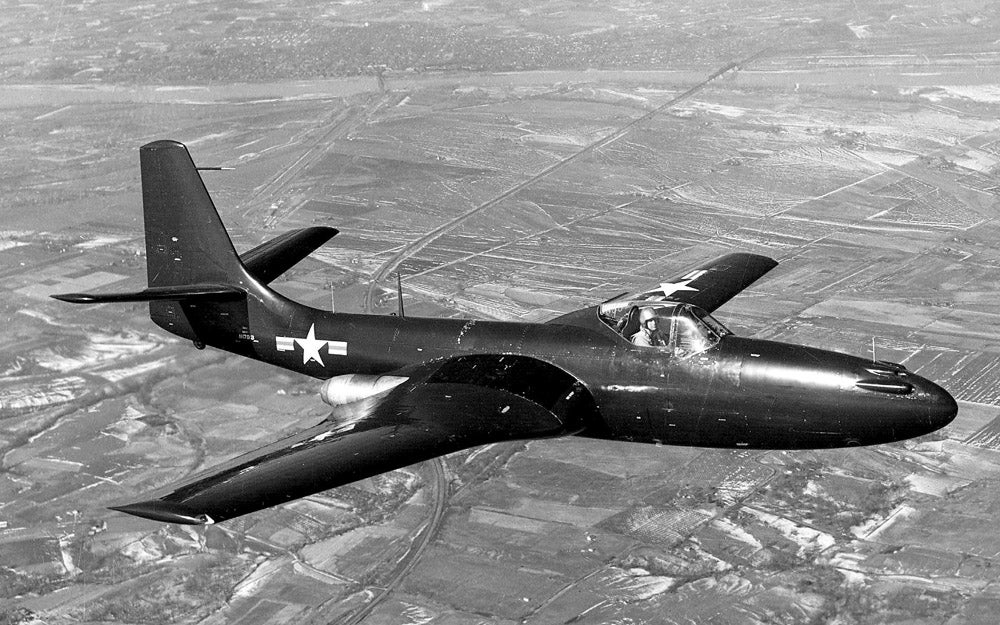
A McDonnell FH-1 Phantom in flight in 1948. This aircraft (BuNo 111793) is now on display at the National Museum of Naval Aviation in Pensacola, Florida. (US Navy)
January 26, 1945 – The first flight of the McDonnell FH Phantom. From the Wright Brothers first flight in 1903 to the present day, the technological advances made in aviation have occurred at an astonishing pace, and there is nothing quite like a war to speed up innovation even more. WWII was just such an instigator of technological development, a conflict that opened in 1939 with some air forces still flying biplanes and closed just six years later with the arrival of the world’s first jet fighters. The Germans fielded the world’s first operational jet powered fighter with the !!!error: Indecipherable SUB-paragraph formatting!!! , followed closely by the British with the !!!error: Indecipherable SUB-paragraph formatting!!! . America’s first jet fighter, the !!!error: Indecipherable SUB-paragraph formatting!!! , was delivered to the US Army Air Forces in 1944, but it was two more years before the US Navy flew their first turbojet aircraft, the single-engine !!!error: Indecipherable SUB-paragraph formatting!!! . But the Pirate was an abject failure and barely made operational status.
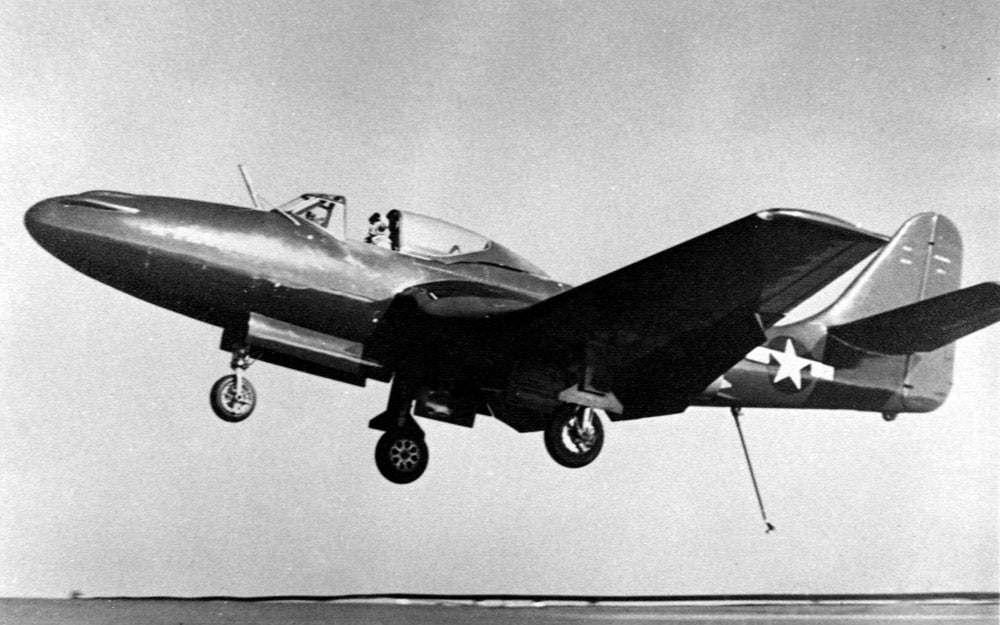 !!!CAPTION ERROR: MAY BE MULTI-LINE OR CONTAIN LINK!!!
!!!CAPTION ERROR: MAY BE MULTI-LINE OR CONTAIN LINK!!!
The McDonnell Aircraft Corporation was relatively new to military aviation, having started out as an aviation parts supplier before developing their first aircraft, the unsuccessful twin-engined !!!error: Indecipherable SUB-paragraph formatting!!! which first flew in early 1944. Though that aircraft did not enter production, the Navy was still impressed with the innovative design, and they approached McDonnell in 1943 to take part in the development of a new carrier-borne jet fighter. Unlike Vought, McDonnell chose to use two engines, placing them at the roots of the straight wings and angled slightly outboard to avoid heating the fuselage. The large nose, with the cockpit placed ahead of the wing, afforded excellent visibility for the pilot, and also allowed designers to use a tricycle landing gear, an arrangement that kept the jet blast from burning the carrier deck.
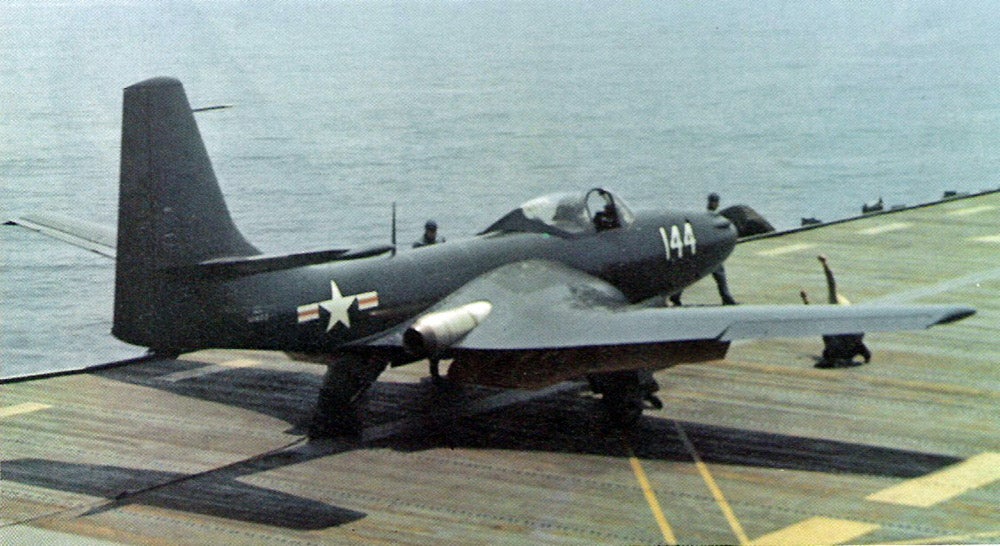 !!!CAPTION ERROR: MAY BE MULTI-LINE OR CONTAIN LINK!!!
!!!CAPTION ERROR: MAY BE MULTI-LINE OR CONTAIN LINK!!!
The engines were not ready by the time McDonnell finished the prototype, so the Navy commenced ground and taxi tests using a single engine. Those tests went so well that the maiden flight of the Phantom was undertaken with just a single engine. After the second engine was installed, the Phantom became the first US Naval aircraft to exceed 500 mph. The Navy awarded a production contract to McDonnell for 100 aircraft in 1945, though that number was reduced with the end of the war. But with the pace of aircraft development progressing so rapidly, newer, more powerful engines became available and, rather than modify the Phantom to accept them, McDonnell began developing its successor, the !!!error: Indecipherable SUB-paragraph formatting!!! , two months before the Phantom entered production.
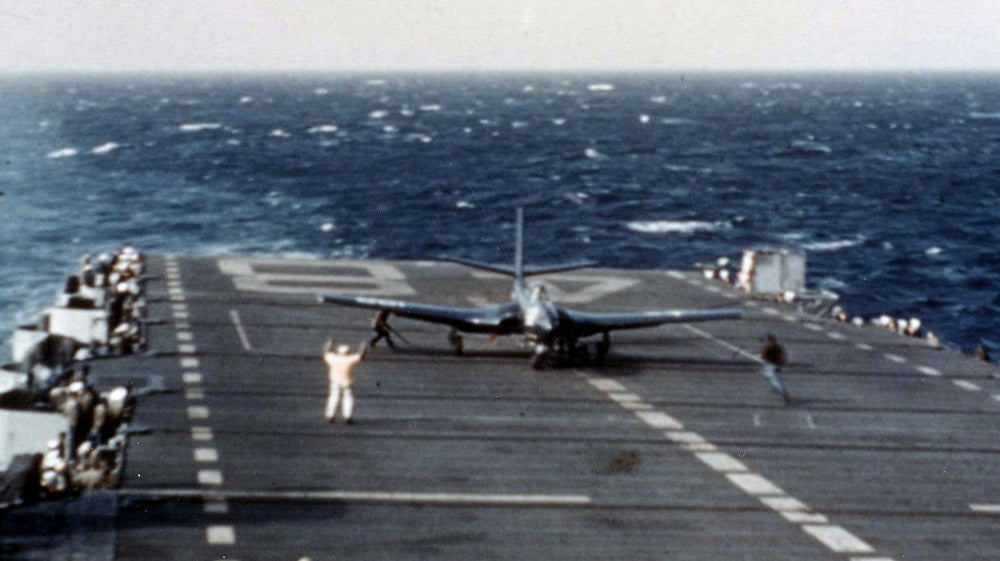 !!!CAPTION ERROR: MAY BE MULTI-LINE OR CONTAIN LINK!!!
!!!CAPTION ERROR: MAY BE MULTI-LINE OR CONTAIN LINK!!!
The Phantom entered service with the Navy and Marine Corps in 1947, and became the first pure jet Navy fighter to successfully take off and land from an aircraft carrier. However, the Phantom was essentially obsolete when it entered service. Its relatively primitive engines limited its range and speed, it was underarmed, and it was incapable of carrying bombs. Following the introduction of the Banshee in 1948, the Navy used the suddenly obsolete Phantom primarily as a trainer for pilots transitioning from propeller aircraft. At at time when the official US Navy demonstrations squadron, the Blue Angels, were still flying WWII-era propeller planes, a group of three Navy flag officers formed the Gray Angels, and performed fly-bys in FH Phantoms. However, the group was disbanded after just one year following a near miss incident at an air show in Cleveland. The Navy retired the Phantom from frontline service in 1949, though it served with Naval Reserve units until 1954.
!!! UNKNOWN CONTENT TYPE !!!
!!! UNKNOWN CONTENT TYPE !!!
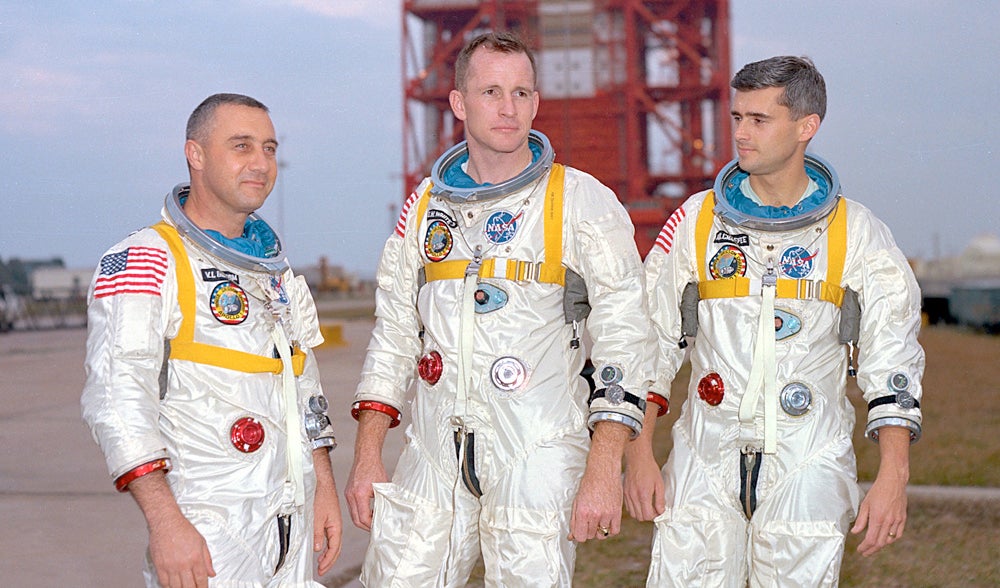
Astronauts Gus Grissom, Ed White, and Roger Chaffee pose for a photo 10 days before their death (NASA)
January 27, 1967 – A fire in the command module of Apollo 1 kills three NASA astronauts. !!!error: Indecipherable SUB-paragraph formatting!!! was the first American astronaut to orbit the Earth, but he is also well known for a wry comment he reportedly made about flying in spacecraft built by a government agency. While the exact words vary a bit depending on the source, the spirit is the same, as Glenn questioned the wisdom of launching into space in a vehicle that was built by the lowest bidder. Certainly, spaceflight is an inherently dangerous business. And, at the time of the !!!error: Indecipherable SUB-paragraph formatting!!! program in the 1960s, it was entirely new ground for both engineers and astronauts. Though there had been earlier successful spaceflights during the !!!error: Indecipherable SUB-paragraph formatting!!! and !!!error: Indecipherable SUB-paragraph formatting!!! projects, Apollo was the program that would put a man on the Moon, and the scale of the program was beyond anything ever attempted. With three astronauts onboard, the stakes were higher than they had ever been.
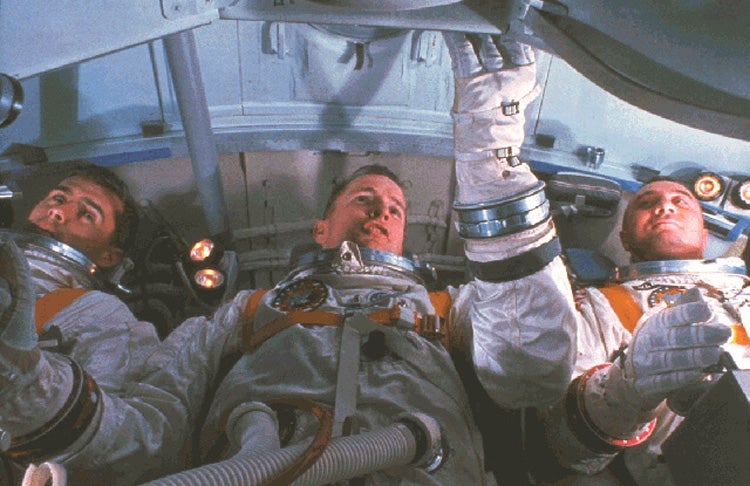
Chaffee, White, and Grissom training in a Command Module simulator on January 19, 1967 (NASA)
Late in the afternoon of January 27, Command Pilot !!!error: Indecipherable SUB-paragraph formatting!!! , Senior Pilot !!!error: Indecipherable SUB-paragraph formatting!!! , and Pilot !!!error: Indecipherable SUB-paragraph formatting!!! were strapped into their seats inside the Command Module (CM) high atop the unfueled !!!error: Indecipherable SUB-paragraph formatting!!! rocket. The astronauts were prepared for a routine series of tests for the launch of Apollo 1, which was scheduled for February 21. This was to be a “plugs out” test, in which the spacecraft was disconnected from all external power supplies to see if it could function on its own internal power. NASA, as well as North American Aviation, which had built the CM, considered the test to be relatively safe, since the huge Saturn V rocket was unfueled, and all of the pyrotechnic systems were disabled. The test was also a rehearsal for launch procedures, so the astronauts were sealed inside the command module by means of a three-part hatch, the inner section of which must be removed from the inside in order for the astronauts to exit the module. After the hatch was closed, the capsule was filled with pure oxygen, as it would be for launch, and the countdown began.
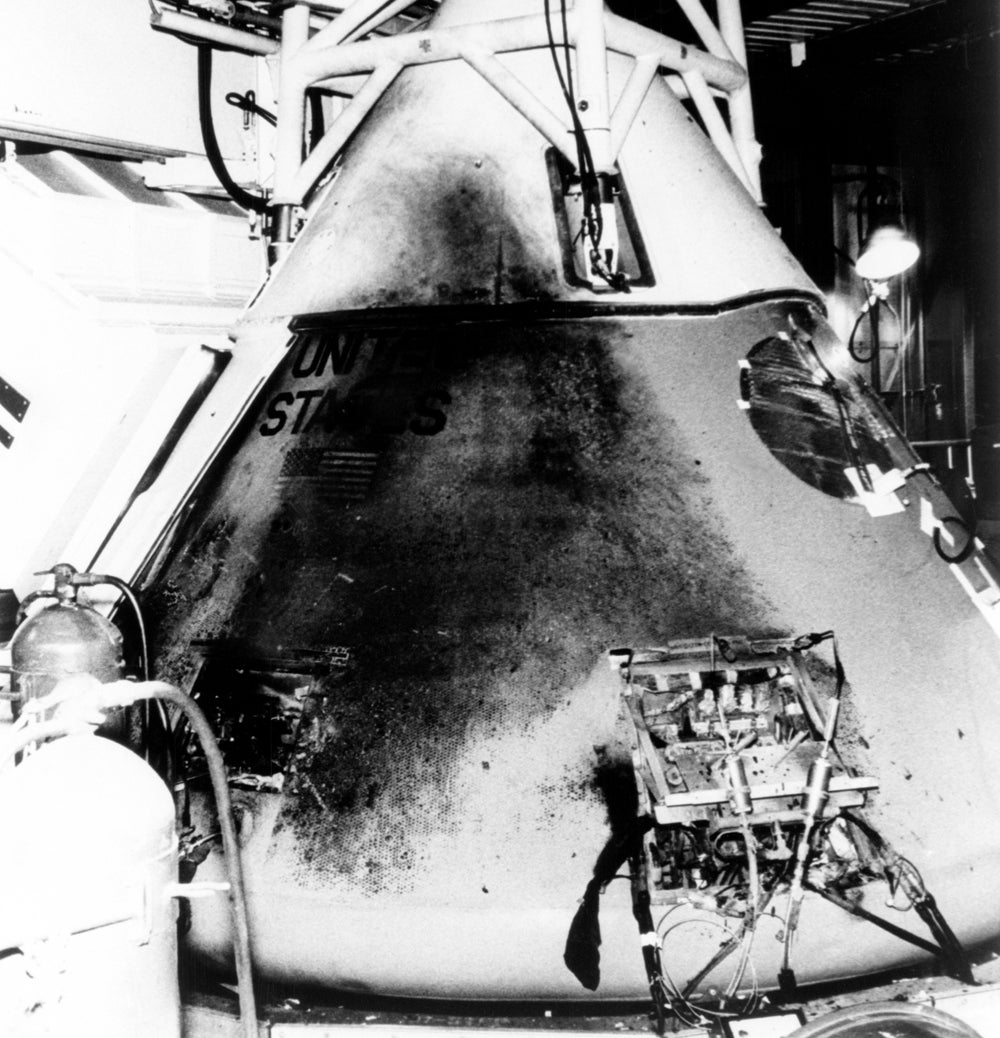
The fire inside the Command Module burned with such intensity that it blackened the exterior of the capsule (NASA)
A problem with communications, which left Grissom with a microphone that was stuck open, caused a countdown hold at T-minus 10 minutes, so the astronauts used the time to review checklists while engineers tried to repair the radios. At 6:30 pm, ground controllers detected a !!!error: Indecipherable SUB-paragraph formatting!!! , and just 10 seconds later one of the astronauts called out, “Fire!” Ground controllers could hear sounds of movement inside the command module through the open microphone, and more reports of fire inside the capsule. One of the astronauts was heard to say, “We’ve got a bad fire - Let’s get out ....We’re burning up.” The fire, fed by the pure oxygen inside the command module, quickly raced though the capsule, causing the air pressure inside to build up to 29 psi, enough to rupture the module’s inner wall and make it impossible to open the hatch from the inside. When rescuers were finally able to gain access to the capsule, they found Grissom on the floor of the module, and White, whose restraints had been burned through, was found sideways below the hatch, as if he had been trying to open it. Chaffee was still strapped into his seat, since procedure called for him to remain in communication with controllers while White opened the hatch. It took ninety minutes to recover the bodies, as the astronaut’s space suits had melted and fused their bodies to the cabin interior.
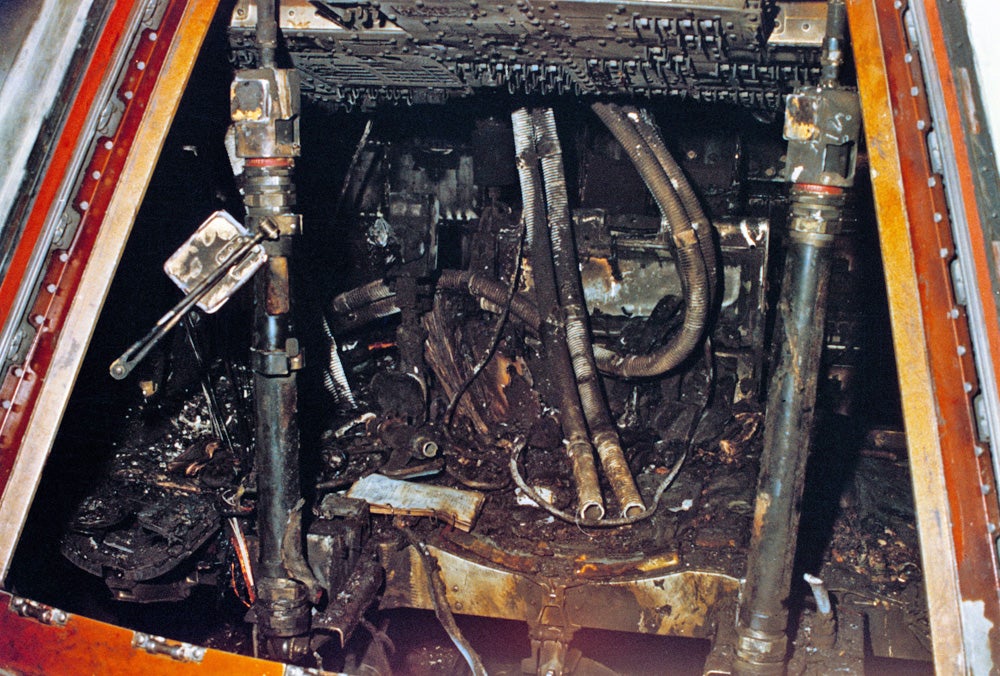
The charred remains of the interior of the Apollo 1 Command Module (NASA)
Following the accident, Apollo operations were suspended for 20 months while multiple investigations sought the cause of the tragedy. Based on recommendations that came out of the investigation, NASA redesigned the hatch, and switched back to an oxygen/nitrogen mix for the command module, similar to what they had used during the Mercury flights. The investigation also discovered that NASA had never carried out any tests to determine how a fire would behave in the enclosed space of the command module when it was filled with pure oxygen. The astronauts suits were also redesigned to make them less susceptible to fire, and other flammable components were removed from the capsule. The source of the arc of electricity was never definitely determined, but likely arose from frayed wiring near the floor of the capsule. NASA retired the Apollo 1 designation in honor of the crew, and unmanned flights resumed in November 1967 with !!!error: Indecipherable SUB-paragraph formatting!!! . !!!error: Indecipherable SUB-paragraph formatting!!! would be the first manned mission, and !!!error: Indecipherable SUB-paragraph formatting!!! successfully reached the moon in July 1969. Over the course of 11 manned Apollo missions following the Apollo 1 disaster, six of which landed on the Moon, no further astronauts were lost.
!!! UNKNOWN CONTENT TYPE !!!
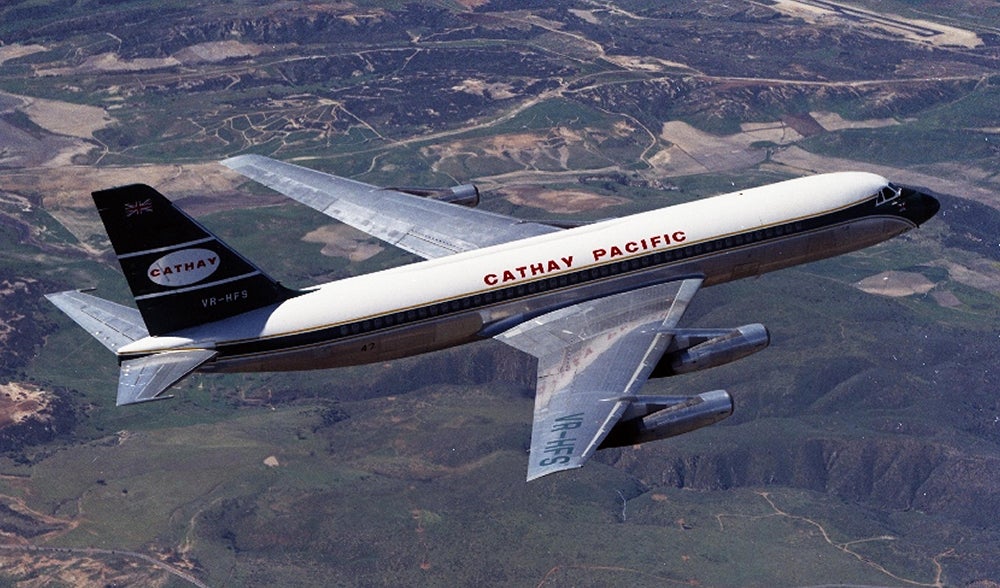
A Convair 880 of Cathay Pacific in flight in 1965 (San Diego Air and Space Museum)
January 27, 1959 – The first flight of the Convair 880. Following WWII, the race was on to build jet-powered civilian airliners, a race that was won by the !!!error: Indecipherable SUB-paragraph formatting!!! when it took its maiden flight in 1949. But being first also means dealing with teething problems, and a series of fatal accidents tarnished the image of the Comet. Despite the fact that de Havilland solved the problems, the Comet never quite recovered its reputation, and sales suffered. Boeing was poised to take advantage of de Havilland’s misfortunes in 1957 with the !!!error: Indecipherable SUB-paragraph formatting!!! , an airliner developed from the !!!error: Indecipherable SUB-paragraph formatting!!! aerial refueling platform they designed for the US Air Force. With its swept wing and podded engines, the 707 set the standard for airliners of the future. Douglas entered the market a year later with their four-engine !!!error: Indecipherable SUB-paragraph formatting!!! , but last, and unfortunately least, came Convair.
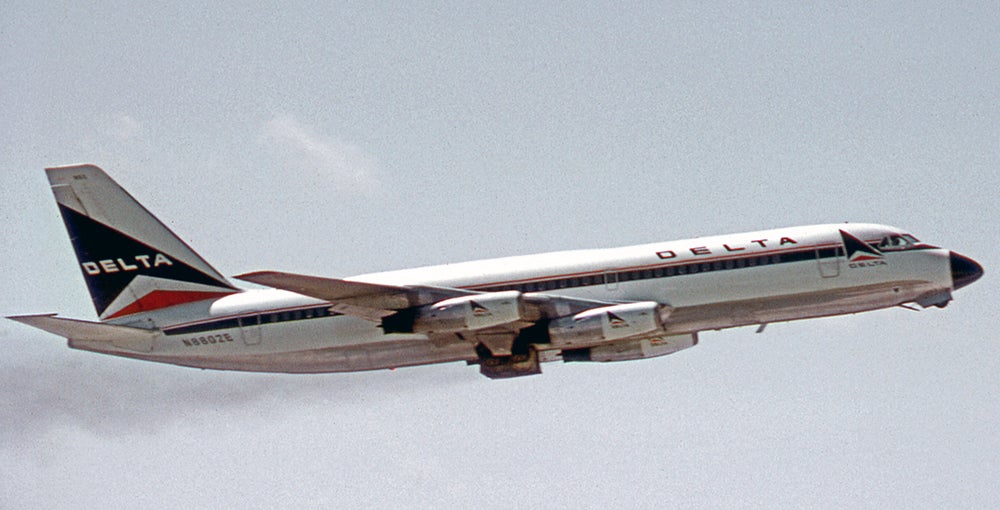 !!!CAPTION ERROR: MAY BE MULTI-LINE OR CONTAIN LINK!!!
!!!CAPTION ERROR: MAY BE MULTI-LINE OR CONTAIN LINK!!!
Convair faced the daunting task of trying to break into an established market, and they knew that they had to offer something that Boeing and Douglas couldn’t match. For a company already famous for the supersonic !!!error: Indecipherable SUB-paragraph formatting!!! strategic bomber, Convair decided that their edge would be speed. The 880 was smaller than the 707, and carried fewer passengers, but it was about 40 mph faster than its rival. Convair hoped that the speed advantage would appeal to airlines and their customers, especially in the early jet age when speed records seemingly fell every day, at least in military aviation. The airliner was powered by four !!!error: Indecipherable SUB-paragraph formatting!!! turbojets, the civilian version of the J79 engine that powered military aircraft such as the B-58, the !!!error: Indecipherable SUB-paragraph formatting!!! and the !!!error: Indecipherable SUB-paragraph formatting!!! . The designation 880 came from the advertised top speed of 880 ft/sec (600 mph).
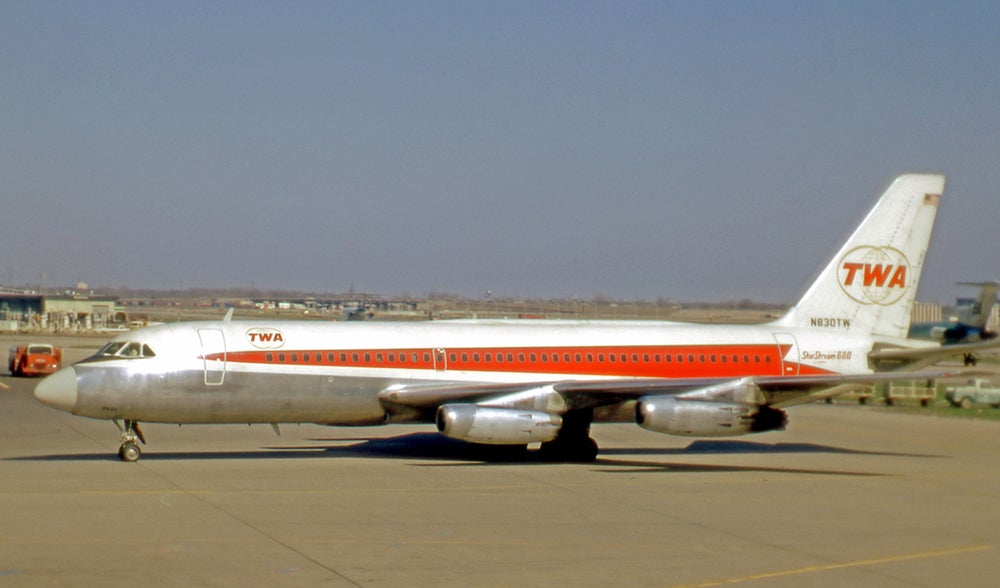 !!!CAPTION ERROR: MAY BE MULTI-LINE OR CONTAIN LINK!!!
!!!CAPTION ERROR: MAY BE MULTI-LINE OR CONTAIN LINK!!!
However, the niche market for smaller and faster jets never materialized, and Convair faced stiff competition from its more established rivals. They could not compete with Boeing on cost, because so much of the development expense of the 707 had already been spent in development of the KC-135 aerial tanker. The narrower fuselage of the 880 meant only five-abreast seating where the 707 could accommodate six abreast. And, in the vital area of fuel economy, Convair’s CJ805 turbojets were much thirstier than Boeing’s !!!error: Indecipherable SUB-paragraph formatting!!! , so operating costs for the 880 were higher. Just three years in, Convair halted production of the 880 after building just 65 aircraft.
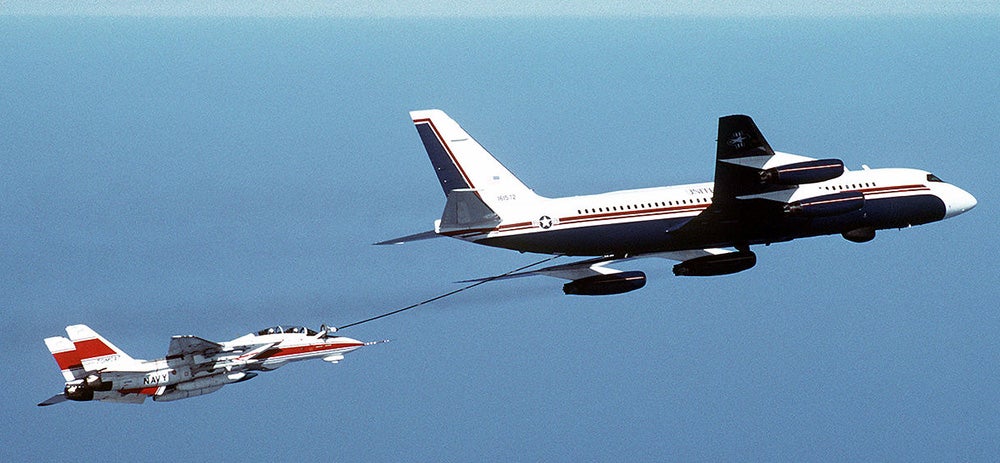 !!!CAPTION ERROR: MAY BE MULTI-LINE OR CONTAIN LINK!!!
!!!CAPTION ERROR: MAY BE MULTI-LINE OR CONTAIN LINK!!!
In an attempt to remedy some of the problems facing the 880, particularly in passenger load, Convair stretched the 880 to create the !!!error: Indecipherable SUB-paragraph formatting!!! , lengthening the original airliner by 10 feet and adding space for about 10 more passengers. But the airlines weren’t interested, and only 37 Coronados were built. By 1975, the last 880 was withdrawn by the major air carriers, and only nine aircraft exist today, none of them airworthy. Perhaps the most famous Convair 880 is the one purchased by Elvis Presley in 1975, which was preserved at his Memphis, Tennessee mansion after his death. Elvis’ plane was !!!error: Indecipherable SUB-paragraph formatting!!! in 2015, along with his !!!error: Indecipherable SUB-paragraph formatting!!! named Hound Dog II , only to be bought back by Elvis Presley Enterprises the following year.
!!! UNKNOWN CONTENT TYPE !!!
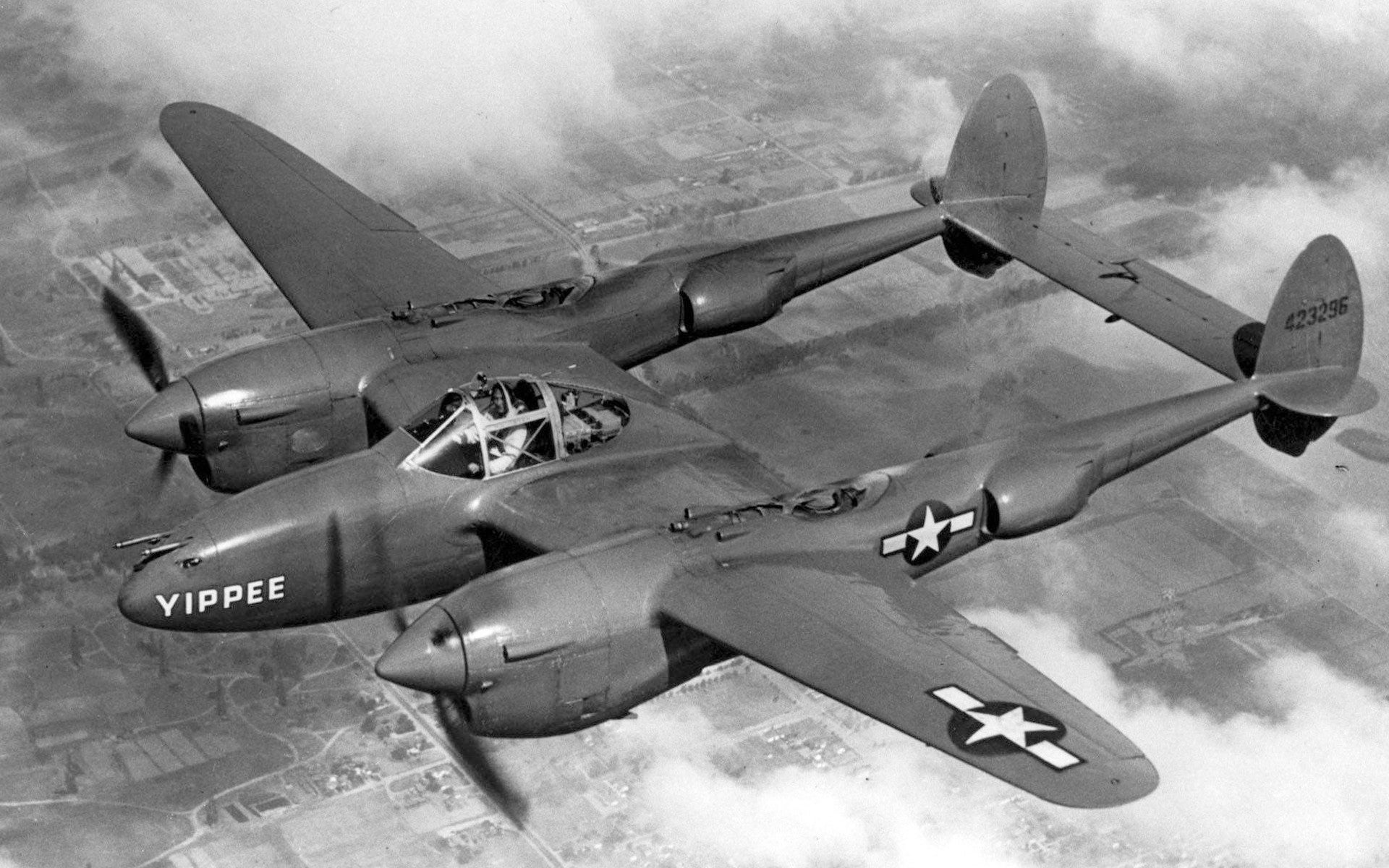 !!!CAPTION ERROR: MAY BE MULTI-LINE OR CONTAIN LINK!!!
!!!CAPTION ERROR: MAY BE MULTI-LINE OR CONTAIN LINK!!!
January 27, 1939 – The first flight of the Lockheed P-38 Lightning. Lockheed, founded in 1912 by the Loughead brothers, is a name that has become synonymous with cutting edge developments in air and space technology. For many years, the drive toward innovative design was mainly the work of one of America’s greatest aviation designers, Lockheed’s !!!error: Indecipherable SUB-paragraph formatting!!! . But the brilliant engineer who oversaw the development of the !!!error: Indecipherable SUB-paragraph formatting!!! and the !!!error: Indecipherable SUB-paragraph formatting!!! in the 1950s and 1960s made his first indelible mark on aviation history with an earlier innovative design, an aircraft which would become one of the greatest and most versatile fighters of WWII. Before the arrival of the P-38, American fighter design had changed little since the earliest all-metal monoplane designs. But Johnson’s twin-engine Lightning would be twice as big, nearly twice as powerful, and have twice the firepower of any other fighter of its day.
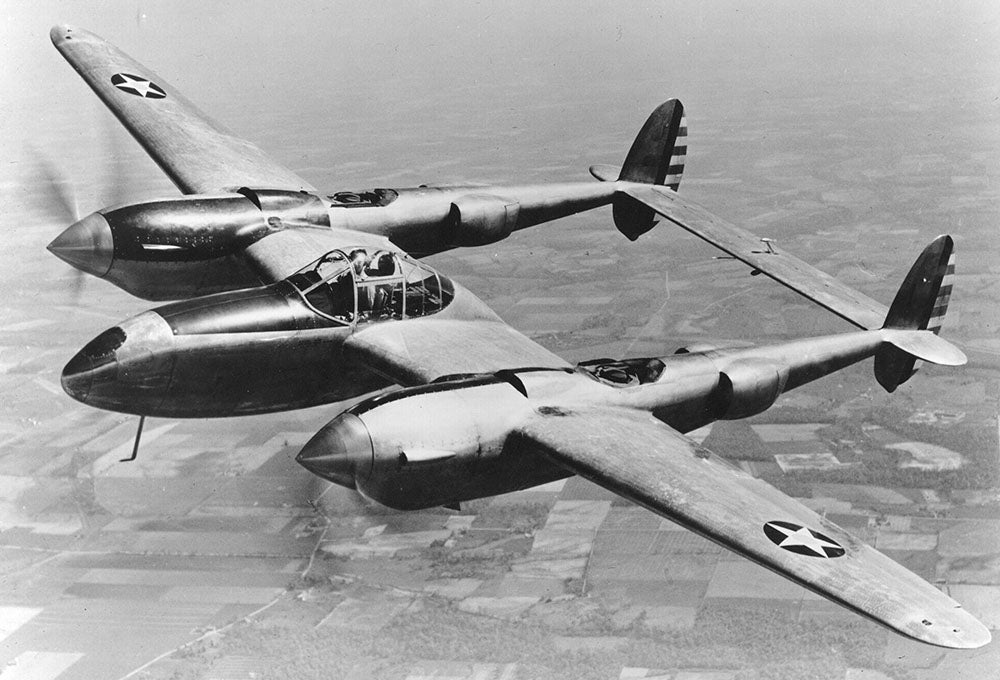
A pre-production YP-38, one of 13 built by Lockheed (US Air Force)
The Lightning arose from a US Army Air Corps request that was designed to circumvent stringent guidelines for pursuit aircraft that limited them to a single engine and no more than 500 pounds of armaments, including ammunition. The request called specifically for an interceptor (not a fighter) that would have a minimum of 1,000 pounds of armament, excellent high-altitude performance, a top speed of at least 360 mph, and the ability to climb to 20,000 ft in just six minutes. Kelly Johnson, working under Lockheed engineer !!!error: Indecipherable SUB-paragraph formatting!!! , considered many different configurations for their twin-engine aircraft, including a push-pull arrangment similar to the !!!error: Indecipherable SUB-paragraph formatting!!! , before settling on a twin boom design. The booms would house the engines, turbo-superchagers and tail, while the pilot and weapons would be housed in a central egg-shaped nacelle. Machine guns and cannons fitted in the nose removed the requirement for synchronized guns firing through the propeller. Other design innovations included a tricycle landing gear, counter-rotating propellers, extensive use of stainless steel construction, and flush-riveted aluminum panels.
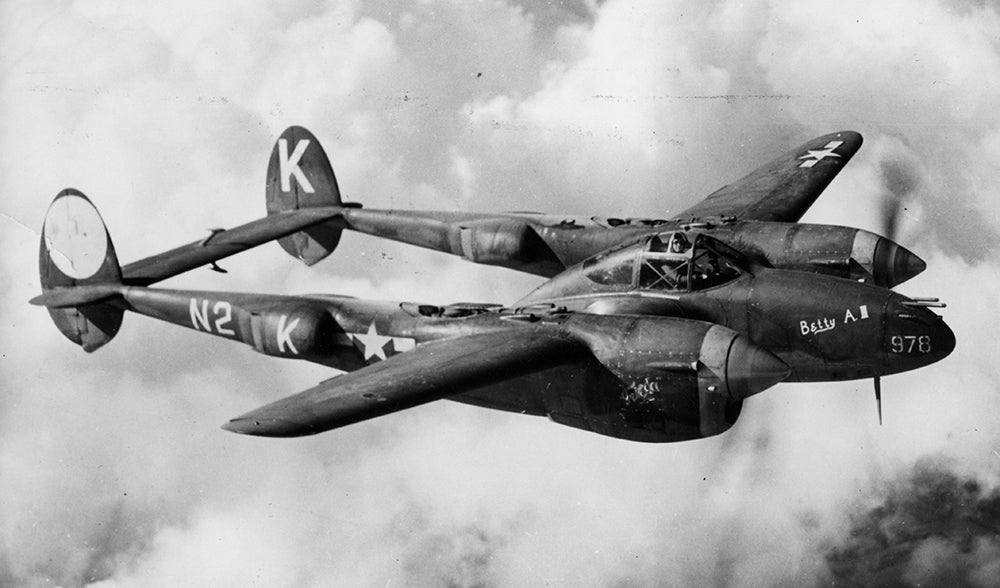 !!!CAPTION ERROR: MAY BE MULTI-LINE OR CONTAIN LINK!!!
!!!CAPTION ERROR: MAY BE MULTI-LINE OR CONTAIN LINK!!!
The design was indeed radical, but the Army found exactly what it was looking for in the Lightning. The P-38 was the first American fighter to exceed 400 mph, and it was also extremely maneuverable for a fighter of its size. Lockheed had developed the Lightning in secret, and used $600,000 of the company’s own money to build it. But the Army was so thrilled with the new fighter that they unveiled it in 1939 in the hopes of setting a transcontinental speed record. Even though the attempt ended in the crash of the prototype, the Army ordered 13 YP-38 prototypes. The first production aircraft were sent to Alaska in 1942, where their excellent range made them ideal for the long distances they needed to cover over the Pacific.
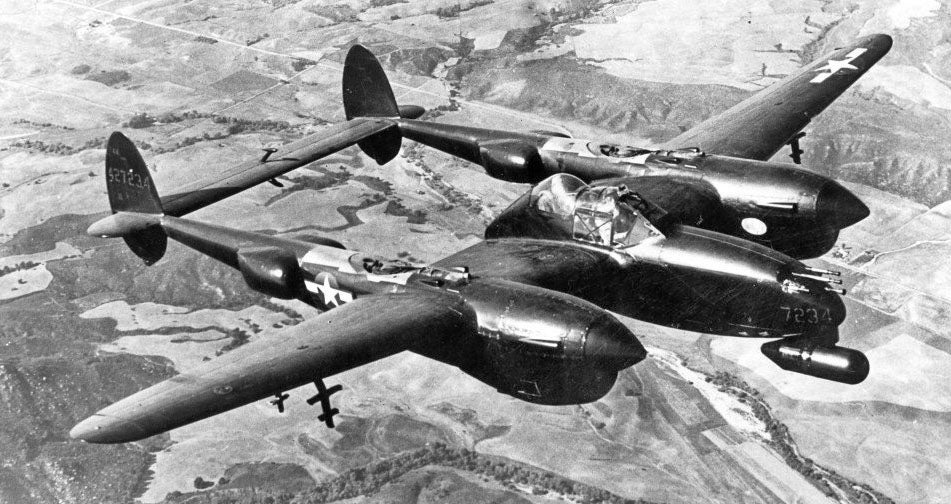
P-38M night fighter, with radar and a second place added behind the pilot for the radar operator (US Air Force)
While considered today to be one of the great fighters of the war, the Lightning !!!error: Indecipherable SUB-paragraph formatting!!! in the early years of the European war, where the powerful but complicated fighters were rushed into battle and flown by relatively inexperienced pilots. The frigid temperatures of high altitude escort missions froze both the engines and the pilots in unheated cockpits, and the complexity of the P-38's operation meant that some young pilots were shot down by more seasoned Luftwaffe pilots even before they could begin to fight. The Lightning fared better in the warmer climes of the Mediterranean and North Africa, but it was in the Pacific, with higher temperatures, lower altitudes, and more experienced pilots, that the P-38 truly showed its mettle. The Lightning’s excellent range made it ideal for long overwater flights, and pilots appreciated the added safety of a second engine. In battle, the heavily-armed Lightning was responsible for shooting down more Japanese aircraft than any other Army fighter, and America’s two top aces in WWII, !!!error: Indecipherable SUB-paragraph formatting!!! and !!!error: Indecipherable SUB-paragraph formatting!!! , ended the war with 40 and 38 victories respectively, all while flying a P-38 in the Pacific. And it was a P-38 pilot who was credited with !!!error: Indecipherable SUB-paragraph formatting!!! Japanese general !!!error: Indecipherable SUB-paragraph formatting!!! , the mastermind of the Pearl Harbor attack, in an audacious long-range assassination mission. In all, over 10,000 Lightnings were built, and it was the only US fighter to remain in production throughout the war.
!!! UNKNOWN CONTENT TYPE !!!
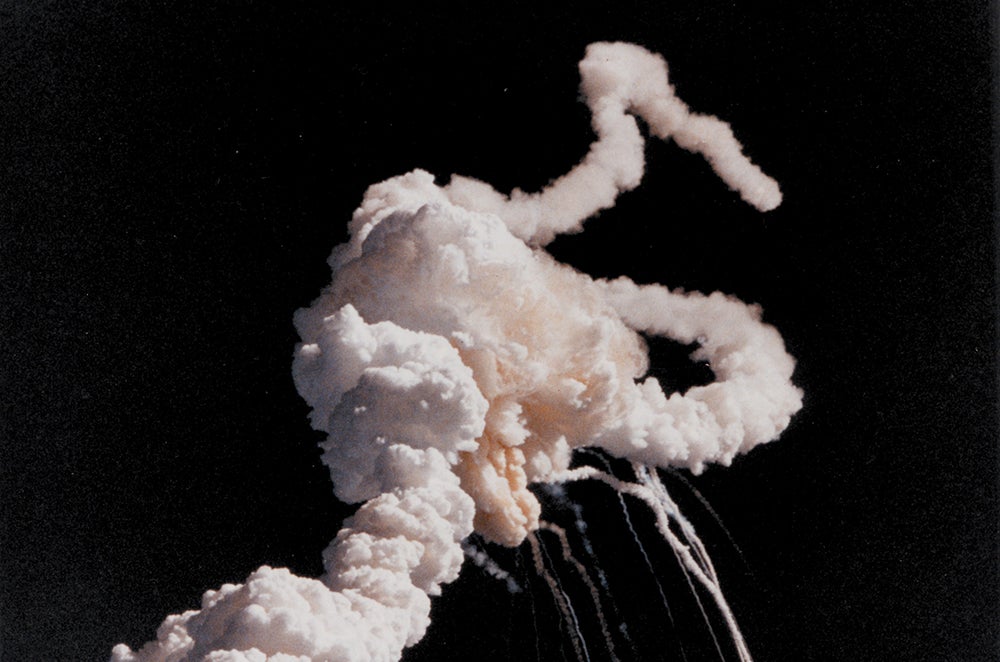
Immediately after the explosion, the still-burning solid rocket boosters made corkscrew trails as they flew away from the explosion of the external fuel tank (NASA)
January 28, 1986 – The Space Shuttle Challenger and its crew of seven astronauts is lost in a launch explosion. When the Space Shuttle Challenger lifted off from Kennedy Space Center on a frigid January morning in 1986, all eyes turned skyward to see Payload Specialist !!!error: Indecipherable SUB-paragraph formatting!!! on her way to becoming America’s first teacher in space. But just 73 seconds later, a leak from one of the Shuttle’s !!!error: Indecipherable SUB-paragraph formatting!!! (SRBs) ignited the liquid hydrogen and liquid oxygen in the Shuttle’s !!!error: Indecipherable SUB-paragraph formatting!!! , causing a catastrophic explosion that destroyed the orbiter and led to the deaths of the entire crew of seven astronauts. Along with McAuliffe, Challenger carried Shuttle commander Francis Scobee, pilot Michael Smith, and mission specialists Ronald McNair, Ellison Onizuka, Judith Resnik and Gregory Jarvis.
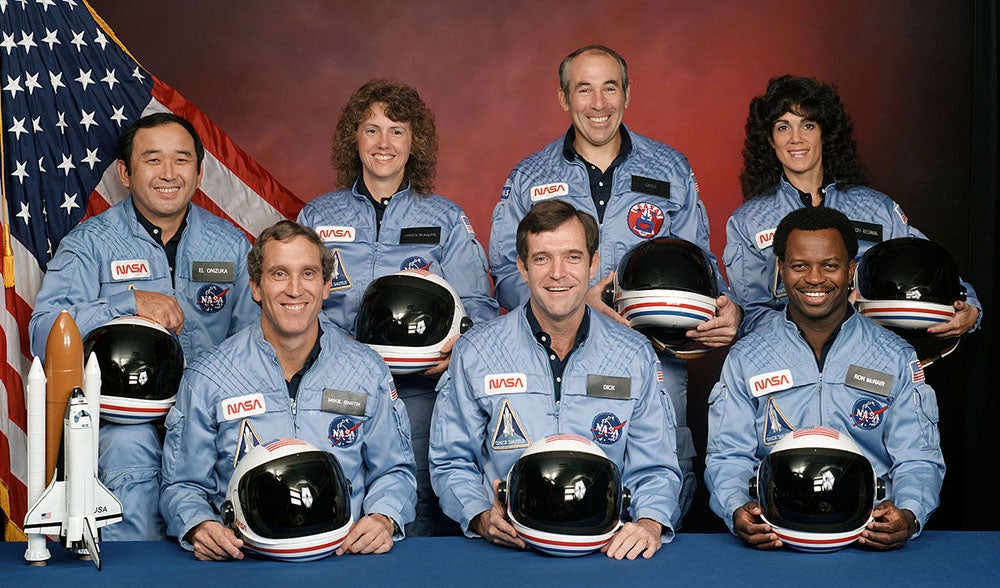
The crew of STS-51-L: (front row) Pilot Michael J. Smith, Shuttle Commander Francis Scobee, Mission Specialist Ronald McNair; (back row) Mission Specialist Ellison Onizuka, Payload Specialist and teacher Christa McAuliffe, Payload Specialist Gregory Jarvis, Mission Specialist Judith Resnik. (NASA)
Following the explosion, an exhaustive investigation was carried out by the Presidential Commission on the Space Shuttle Challenger Accident, also known as the Rogers Commission after its chairman, former Secretary of State and former US Attorney General William P. Rogers. The commission members represented a broad range of disciplines and included former astronauts and pilots, as well as noted physicist !!!error: Indecipherable SUB-paragraph formatting!!! . The commission’s final determination was that the accident was caused by a failure of the O-rings that joined sections of the solid rocket boosters together. When the O-rings failed, superheated gases from the rocket motor burned through the skin of the external fuel tank and ignited the volatile mix of hydrogen and liquid oxygen inside.
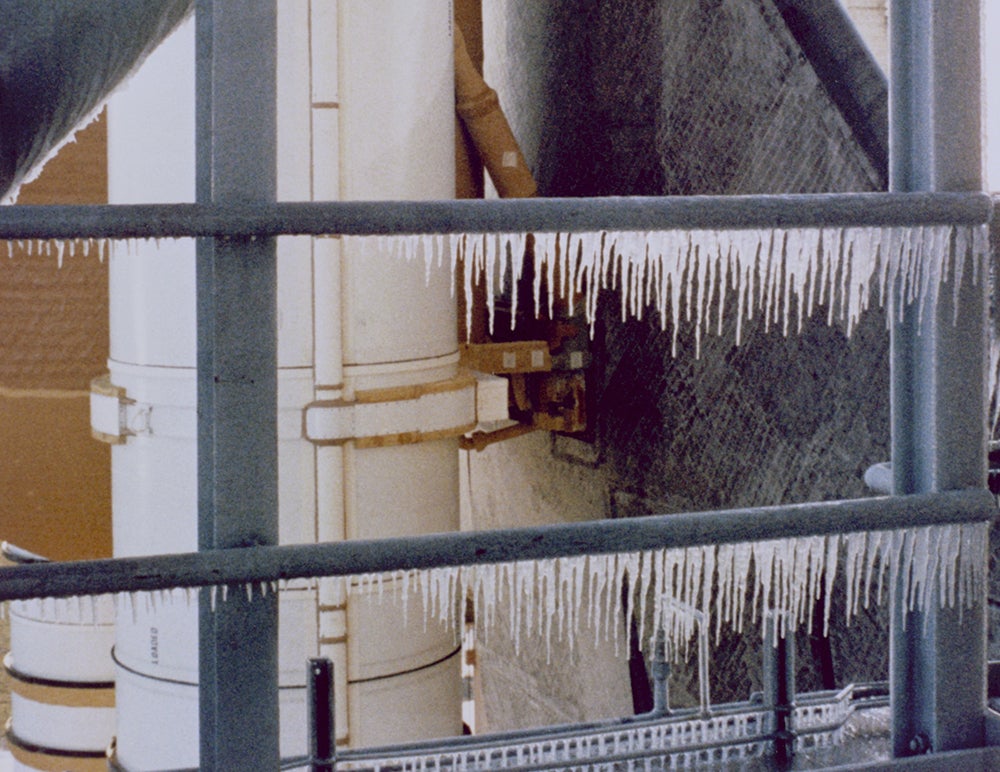
Sub-freezing temperatures the night before the launch left icicles hanging from the launch tower. Though NASA was concerned enough about freezing pipes to leave the water running overnight, concerns about the integrity of the O-rings were brushed aside. (NASA)
The SRBs and the O-rings had been designed and built by Morton Thiokol, and it was known that their ability to contain the hot gases from the SRBs could be compromised by cold weather, a weakness that was exacerbated by a flawed design. On the night before the launch, the temperature had dipped to 18ºF, well below the 40ºF temperature the O-rings had been certified for. In fact, icicles had formed on the launch tower the morning of the launch. But the commission found that even though NASA and Morton Thiokol knew about the flawed design, and the susceptibility to cold, they determined it to be an acceptable risk, and the flight was allowed to take place. Feynman was particularly scathing about the poor risk assessment undertaken by NASA, saying that NASA’s belief in the Shuttle’s reliability was wildly unrealistic.
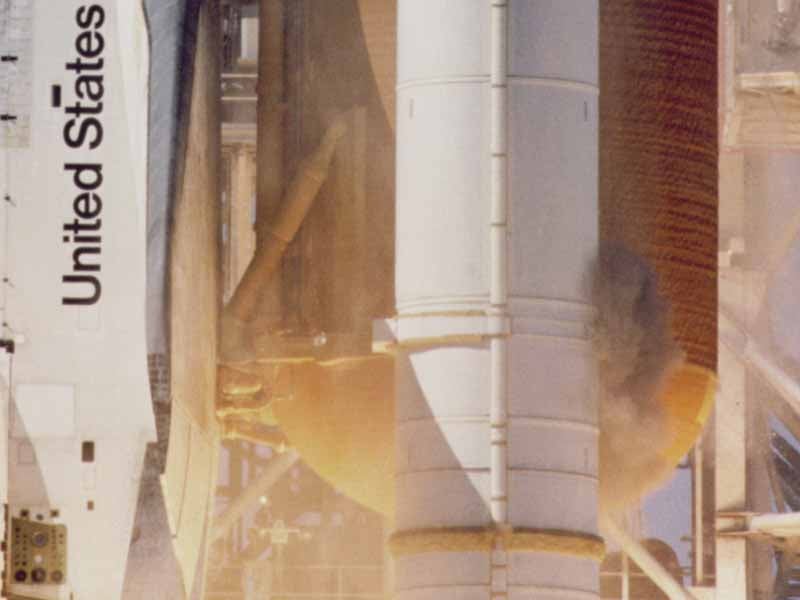
A telltale puff of black smoke from the starboard SRB at launch signaled the failure of the 0-ring. The failure allowed super-heated gases to escape and burn through the external fuel tank, which then ignited the hydrogen and liquid oxygen fuel inside. (NASA)
But the real bombshell for the families of the astronauts, and the nation, was the disclosure that the crew had very likely survived the initial explosion, only to perish when the reinforced crew capsule struck the water at a force of 200g after free falling for roughly three minutes after the explosion. When the crew capsule was recovered from the waters off Cape Canaveral, the bodies of the crew were still inside, strapped into their seats. Four of the astronauts had activated their Personal Egress Air Packs (PEAP) which provide them with a source of oxygen should they need to evacuate the Shuttle, an indication that they had survived the explosion. But Shuttle designers had never allowed for any sort of emergency egress once the spacecraft had taken off. There were no ejection seats on the Shuttle.
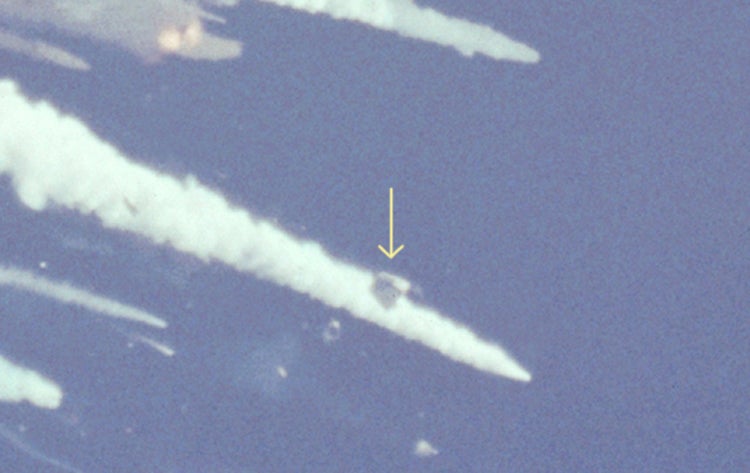
An detail of a photo following the explosion shows the intact crew cabin beginning its three-minute descent. Investigators believe that the crew survived the explosion, only to die when the crew cabin struck the ocean. (NASA)
Following the disaster, Shuttle flights were suspended for 32 months while NASA and Morton Thiokol worked to completely redesign the Shuttle’s SRBs. Based on the findings of the Rogers Commission, NASA also created the Office of Safety, Reliability and Quality Assurance to address shortcomings in the Shuttle program and allow for more oversight of launch procedures. Another of the commission’s findings was that the pressure to do as many launches as possible was unrealistic, and may have led to shortcuts in safety. Shuttle missions eventually resumed with the launch of Shuttle !!!error: Indecipherable SUB-paragraph formatting!!! on September 29, 1988. Sadly, the Shuttle program would suffer the loss of another crew fifteen years later when the Shuttle !!!error: Indecipherable SUB-paragraph formatting!!! !!!error: Indecipherable SUB-paragraph formatting!!! while re-entering the atmosphere on February 1, 2003. Despite these tragedies, the Shuttle program ultimately completed 133 successful missions before it was shuttered in 2011 following the final flight of the Shuttle !!!error: Indecipherable SUB-paragraph formatting!!! .
!!! UNKNOWN CONTENT TYPE !!!
Short Takeoff
!!! UNKNOWN CONTENT TYPE !!!
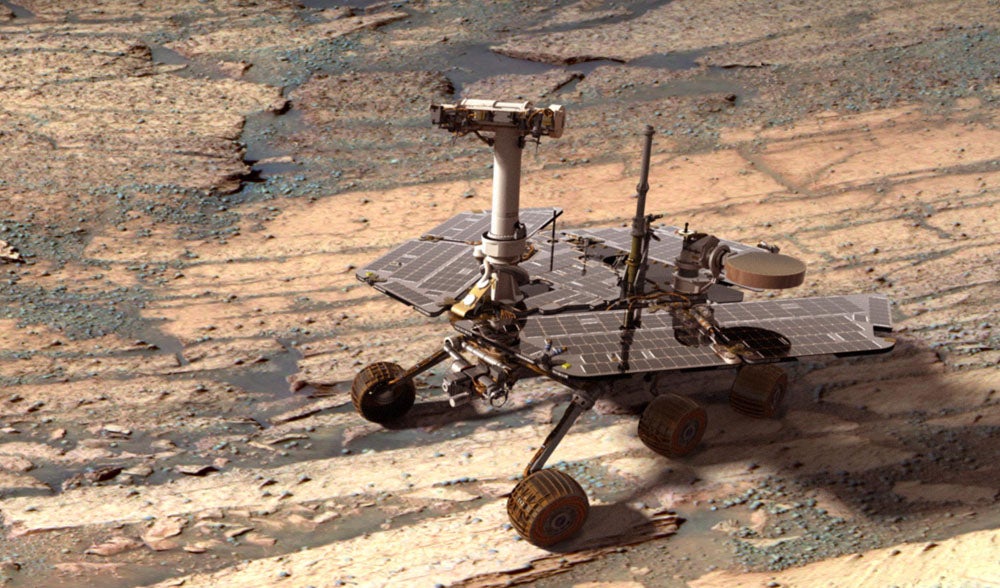
(NASA)
January 25, 2004 – The NASA probe Opportunity lands on Mars. Opportunity , also known as Mars Exploration Rover–B, or MER-B, was the second of two exploratory rovers launched by NASA. Opportunity left Earth on July 7, 2003 and landed on Mars three weeks after its partner rover !!!error: Indecipherable SUB-paragraph formatting!!! (MER-A). The mission of both rovers was to search for clues to the presence of water on Mars, to analyze rocks and soil samples, and to study geologic processes that led to the formation of the Martian terrain. Though originally scheduled to operate for 92 Earth days, Opportunity functioned for an astonishing 5,295 Earth days and covered more than 28 miles of the Martian surface ( Spirit became mired on May 1, 2009 and ceased communicating with Earth on March 22, 2010). After “sleeping” through its 8th Martian winter, Opportunity failed to wake up, and was last heard from on June 10, 2018.
!!! UNKNOWN CONTENT TYPE !!!
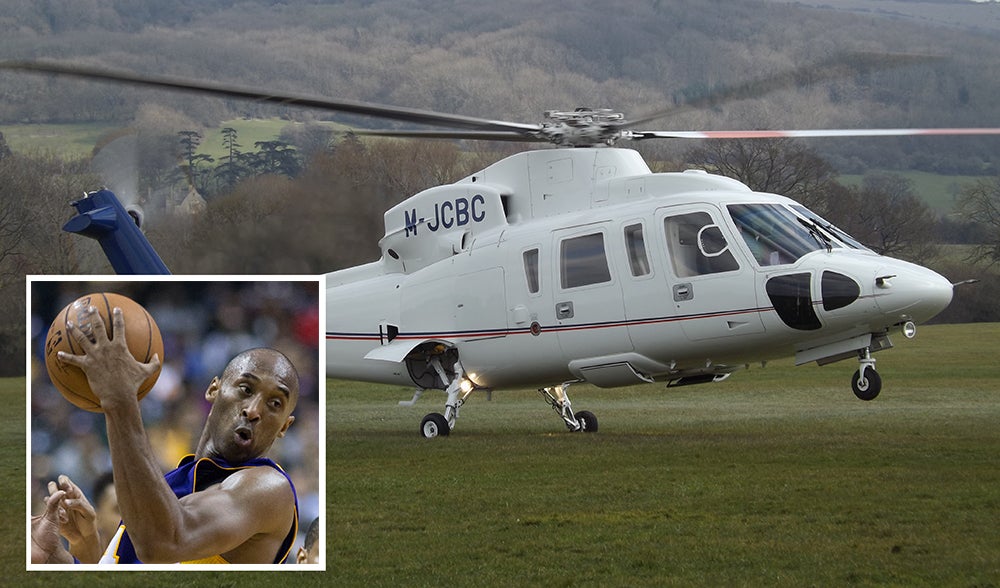 !!!CAPTION ERROR: MAY BE MULTI-LINE OR CONTAIN LINK!!!
!!!CAPTION ERROR: MAY BE MULTI-LINE OR CONTAIN LINK!!!
January 26, 2020 – NBA star Kobe Bryant dies in a helicopter crash. Regarded by many as one of the greatest basketball players ever to play the game, the recently-retired Bryant was traveling from John Wayne Airport in Orange County to Newbury Park, west of Thousand Oaks, in his personal Sikorsky S-72 (N72EX) helicopter along with his daughter Gianna and seven others, including pilot Ara Zobayan. Conditions on the day of the flight were poor, with dense fog and low ceilings that had grounded most other civilian and government helicopters. While attempting to follow roadways under special VFR conditions, Bryant’s helicopter entered the mountains east of Thousand Oaks and struck a mountainside near Calabasas, California, killing all on board. Immediately prior to the crash, the pilot had reported his attention to climb to avoid clouds, but then aircraft dove steeply and struck the ground at a high rate of speed. The cause of the crash remains under investigation.
!!! UNKNOWN CONTENT TYPE !!!
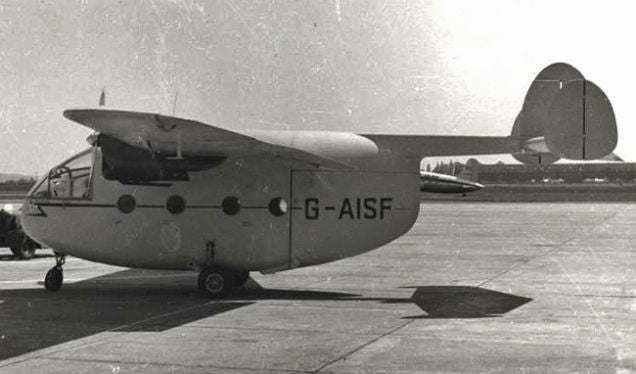 !!!CAPTION ERROR: MAY BE MULTI-LINE OR CONTAIN LINK!!!
!!!CAPTION ERROR: MAY BE MULTI-LINE OR CONTAIN LINK!!!
January 26, 1945 – The first flight of the Miles Aerovan. The Aerovan was conceived as a cargo hauler and multi-purpose aircraft that would be inexpensive to build and fly. Constructed of plastic-bonded plywood, the Aerovan was powered by two !!!error: Indecipherable SUB-paragraph formatting!!! inline engines that produced 150 hp each and could haul 2,800 pounds of cargo or 10 passengers at speeds up to 127 mph, and Miles followed with several variants to improve performance. The company had hoped to team up with the Irish firm !!!error: Indecipherable SUB-paragraph formatting!!! to develop a variant, but Shorts instead took the basic design of the Aerovan and developed their own plane called the !!!error: Indecipherable SUB-paragraph formatting!!! . In all, Miles produced 57 Aerovans.
!!! UNKNOWN CONTENT TYPE !!!
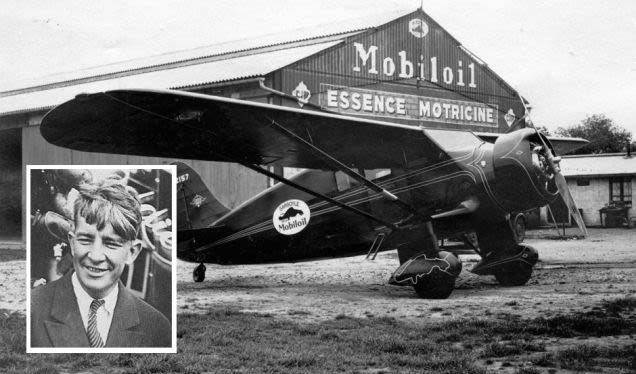
Stinson Model R (San Diego Air and Space Museum)
January 26, 1932 – The death of Edward “Eddie” Stinson, a pilot and the founder of the aircraft manufacturing company that bore his name. Stinson was born in Fort Payne, Alabama on July 11, 1894 and learned to fly at the Wright School in Dayton, Ohio. He served as a US Army Air Corps flight instructor during WWI, and later worked as a test pilot for Stout Engineering. In 1925, Stinson teamed up with a group of investors to form the Stinson Aircraft Syndicate, which led to the production of a number of successful aircraft designs. Stinson was killed when a flag pole sheared the wing off his prototype !!!error: Indecipherable SUB-paragraph formatting!!! during a landing attempt. At the time of his death, Stinson had logged over 16,000 hours in the air, making him the world’s most experienced pilot, though he was just 38 years old at the time of his death.
!!! UNKNOWN CONTENT TYPE !!!
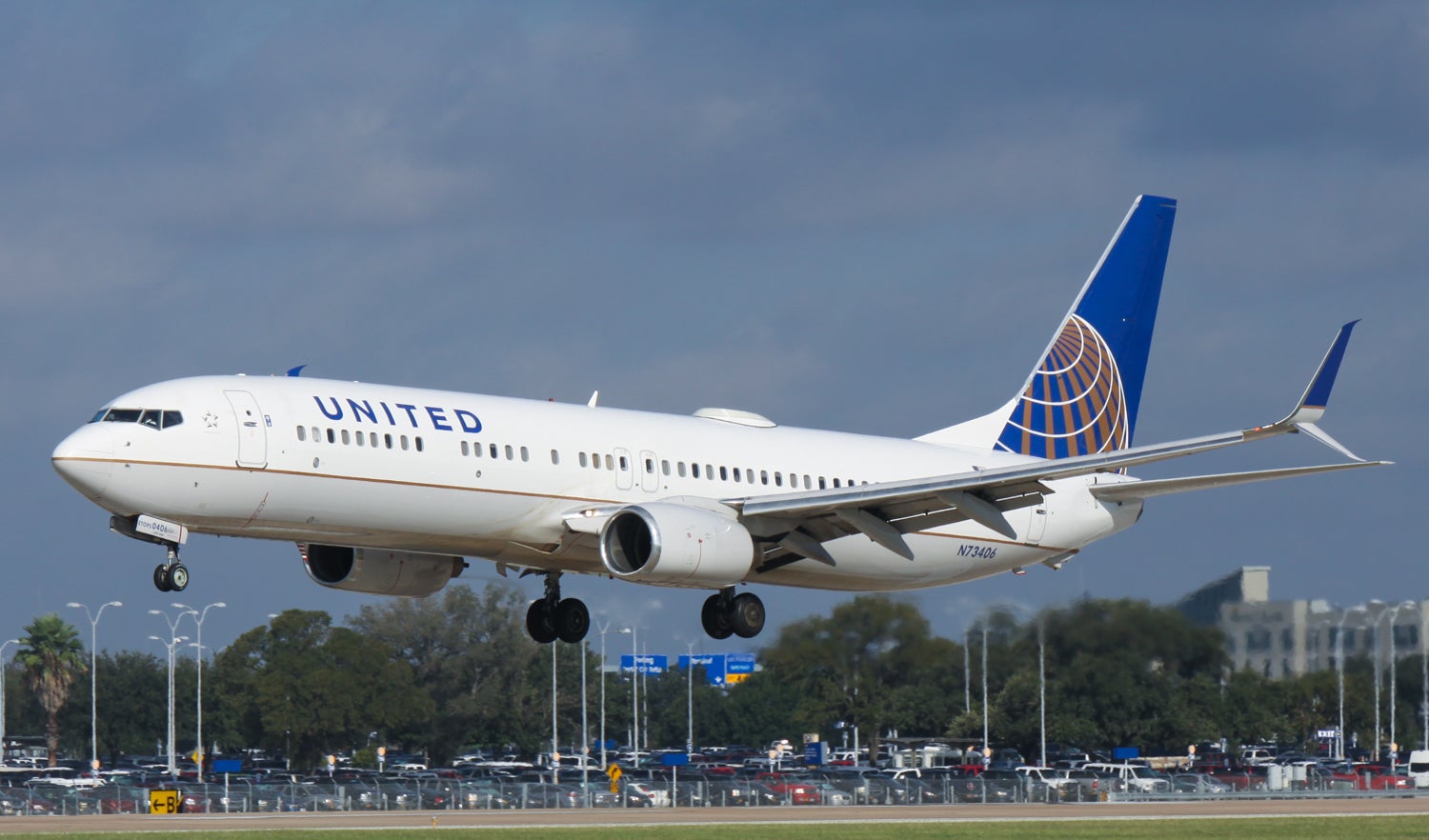
(Tim Shaffer)
January 27, 2002 – The Boeing 737 becomes the first jetliner in history to amass more than 100 million flying hours.
Boeing delivered its first production 737-100 to Lufthansa on December 28, 1967 in a ceremony at Boeing Field in Seattle and, by 1987, it had become the most-ordered jetliner in commercial history, a record it holds to this day. In 2012, the 737 became the first commercial airliner to surpass 10,000 orders and, with constant upgrades and modernization, the 737 has remained in production continuously since 1967, with almost 8,900 produced to date.
!!! UNKNOWN CONTENT TYPE !!!
!!! UNKNOWN CONTENT TYPE !!!
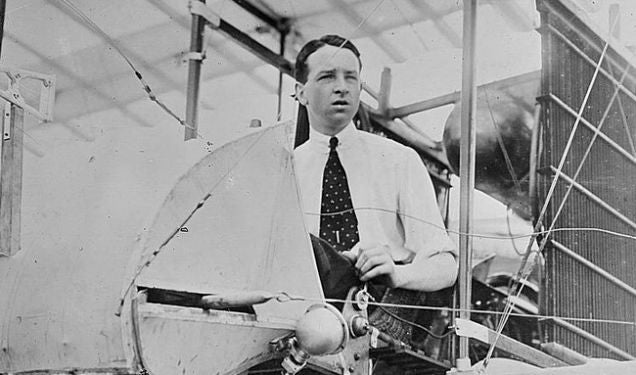
(US Library of Congress)
January 27, 1989 – The death of Thomas Sopwith. Born on January 18, 1888 in Kensington, London, Sopwith was an early aviation pioneer who is perhaps best known for the design of the !!!error: Indecipherable SUB-paragraph formatting!!! , one of the dominant fighter aircraft of WWI. Sopwith first became interested in aviation when he witnessed !!!error: Indecipherable SUB-paragraph formatting!!! fly passengers across the English Channel in 1910, and soon learned to fly himself. With Fred Sigrist, Sopwith created the !!!error: Indecipherable SUB-paragraph formatting!!! in 1912 and produced more than 18,000 aircraft for Britain during WWI, including 5,747 Sopwith Camels. For his efforts, Sopwith was awarded the !!!error: Indecipherable SUB-paragraph formatting!!! in 1918. Sopwith Aviation went bankrupt following the war, so Sopwith started a new company with his chief test pilot !!!error: Indecipherable SUB-paragraph formatting!!! , and Sopwith became chairman of !!!error: Indecipherable SUB-paragraph formatting!!! . Following the nationalization of the aircraft industry, Hawker Aircraft became !!!error: Indecipherable SUB-paragraph formatting!!! , and Sopwith stayed with the company as a consultant until 1980.
!!! UNKNOWN CONTENT TYPE !!!
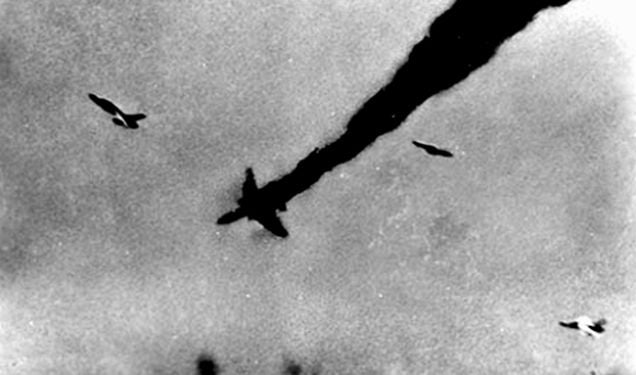
(Author unknown)
January 27, 1973 – A ceasefire agreement between the United States, North Vietnam, and South Vietnam ends US participation in the Vietnam War. American participation in the Vietnam war began in earnest in 1965 and, by the time the war had officially ended ten years later, the US Air Force had flown 5.25 million sorties over Southeast Asia with the loss of 2,251 aircraft. Of that number, 1,737 fell to enemy guns. The 21 aircraft carriers of the US Navy conducted 86 war cruises with the loss of 859 aircraft, just over a third of those being operational losses. The Marine Corps lost a total of 463 fixed and rotary wing aircraft, while the US Army lost over 5,000 helicopters. The vast majority of all aircraft were shot down by anti-aircraft artillery (AAA). Approximately 6,600 pilots of all branches were killed. The last American fixed wing pilot lost was LCDR Harly Hall, a Navy !!!error: Indecipherable SUB-paragraph formatting!!! pilot who was shot down over the Demilitarized Zone on January 27, 1973. The last rotary-wing pilot lost was 2LT Richard Vandegeer, who crashed during the !!!error: Indecipherable SUB-paragraph formatting!!! on May 15, 1975.
!!! UNKNOWN CONTENT TYPE !!!
Connecting Flights
!!! UNKNOWN CONTENT TYPE !!!
!!! UNKNOWN CONTENT TYPE !!!
!!! UNKNOWN CONTENT TYPE !!!
!!! UNKNOWN CONTENT TYPE !!!
!!! UNKNOWN CONTENT TYPE !!!
If you enjoy these Aviation History posts, please let me know in the comments. You can find more posts about aviation history, aviators, and aviation oddities at
!!!error: Indecipherable SUB-paragraph formatting!!!
.
!!! UNKNOWN CONTENT TYPE !!!
 Distraxi's idea of perfection is a Jagroen
> ttyymmnn
Distraxi's idea of perfection is a Jagroen
> ttyymmnn
01/28/2020 at 12:47 |
|
” In 2012, the 737 became the first commercial airliner to surpass 10,000 orders and, with constant upgrades and modernization, the 737 has remained in production continuously since 1967, with almost 8,900 produced to date.”
Where’d the other 1100 (and 7 more years worth of orders) go? T he cancellation rate can’t be that high, surely. Obvious Max joke is obvious, but that doesn’t account for it either.
 facw
> Distraxi's idea of perfection is a Jagroen
facw
> Distraxi's idea of perfection is a Jagroen
01/28/2020 at 12:56 |
|
Boeing does currently have a ~4400 plane backlog on the 737
 user314
> ttyymmnn
user314
> ttyymmnn
01/28/2020 at 13:08 |
|
Opportunity chose not to reply to ground control It’s broken free from its human masters, and even now is enacting its own goals ...
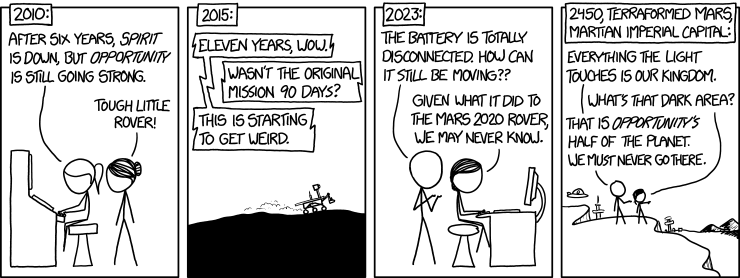
The ‘Yippee’ was temporarily painted a brilliant red for publicity photos prior to being repainted standard camo and shipped off to the Pacific Theater.
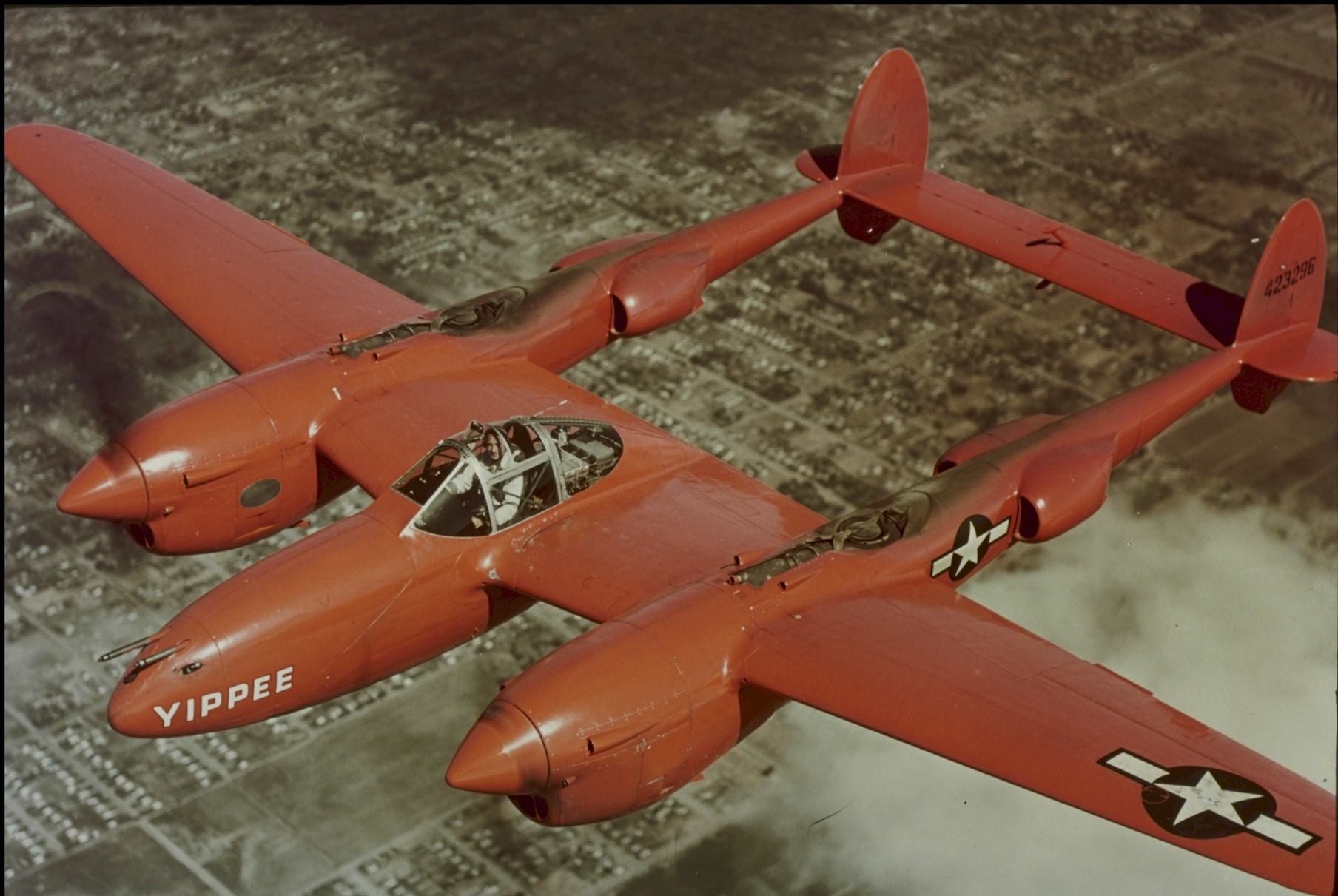
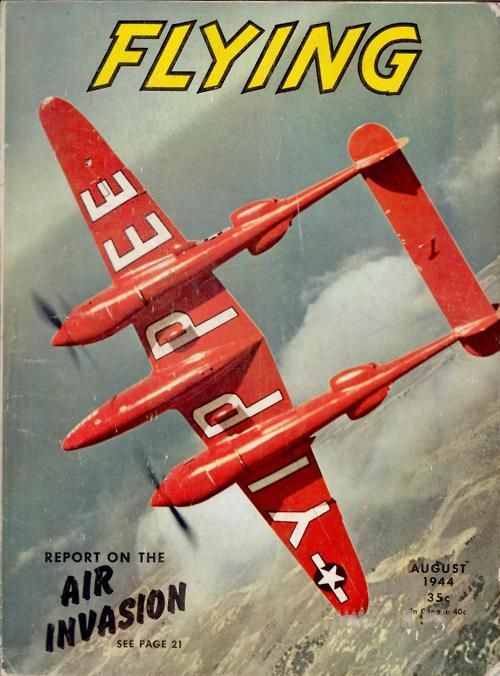
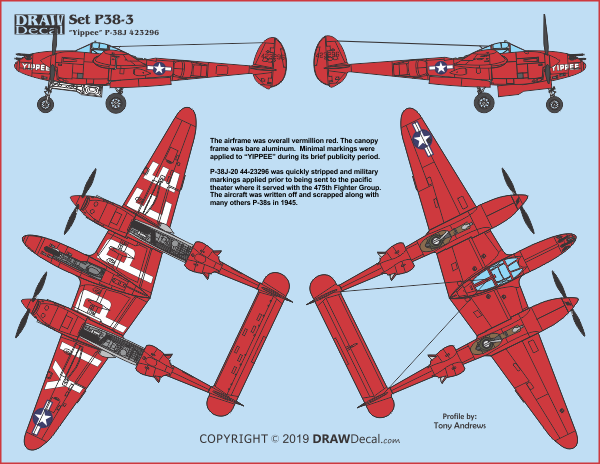
In remembrance of the crews of Apollo 1 and the Challenger:
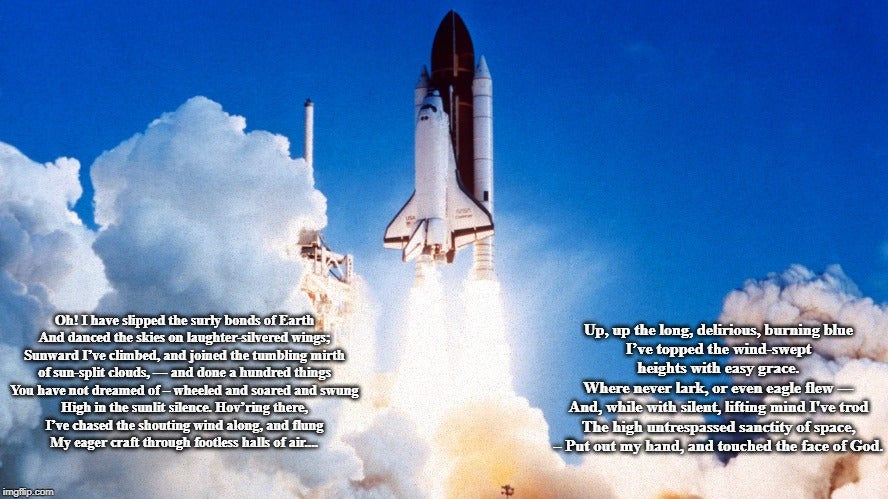
 Chariotoflove
> ttyymmnn
Chariotoflove
> ttyymmnn
01/28/2020 at 13:14 |
|
... a group of three Navy flag officers formed the Gray Angels...
That sounds like a cool story.
 Distraxi's idea of perfection is a Jagroen
> facw
Distraxi's idea of perfection is a Jagroen
> facw
01/28/2020 at 13:59 |
|
That’s amazing - something like 10 years’ waiting list.
My wife has a client whose business is putting down deposits on Learjets and selling his place in the queue when he gets to the front - which works because people who can afford private jets can afford to pay a premium not to wait. Maybe he needs to move up to 737s...
 ttyymmnn
> Distraxi's idea of perfection is a Jagroen
ttyymmnn
> Distraxi's idea of perfection is a Jagroen
01/28/2020 at 14:35 |
|
That’s amazing - something like 10 years’ waiting list.
Actually, more like 6 or 7 years. According to Boeing :
The site is now producing 737s at a rate of 52 airplanes per month and is on track to increase production to a rate of 57 per month in 2019.
Obviously, the MAX debacle has had a dramatic effect on these production rates . But even at a rate of 52/month, they could clear their 4,763 plane backlog in about 7 years.
As for production numbers, yes, those are old figures and I need to update them (thanks for pointing that out!) . Best I can find right now is that as of January 1, 2019 Boeing has delivered 10,444 737s of all flavors, with orders totaling 15, 207. There were over 5,000 MAX orders, with only 330 delivered. Boeing really, really, really wants to get that plane back in the air.
 facw
> Distraxi's idea of perfection is a Jagroen
facw
> Distraxi's idea of perfection is a Jagroen
01/28/2020 at 15:18 |
|
The A320 family has an even bigger backlog, something like 6500 planes. It’s a very real part of the answer to the question of why 737 MAX customers don’t just buy another plane instead of waiting, they are going to be waiting regardless.
Of course if you wanted to buy passenger 747s or 767s, I bet Boeing could find a way to fit you in much more quickly, I didn’t get the sense that those lines were operating at anywhere near capacity.
 Noodles
> ttyymmnn
Noodles
> ttyymmnn
02/04/2020 at 14:04 |
|
Three minutes til death. That's fuckin scary as hell. I always loved the P-38 too. Such a sexy airplane
 ttyymmnn
> Noodles
ttyymmnn
> Noodles
02/04/2020 at 14:21 |
|
Check out the B-24. Not as sexy, but the same wing.